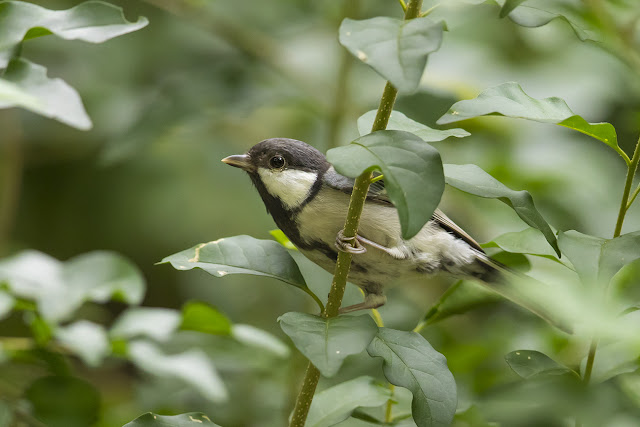Last day of September had me finally able to take a day off work and do a bit of birding. Since I had a full day, I decided to go for a walk at Shek Kong Catchment first before heading to Long Valley to see what's new there. I haven't been to Shek Kong Catchment for a while, so it was really nice to finally visit again after a long summer. I was welcomed by a mixed feeding flock the moment I got off the car, a huge flock of small birds fluttered about near the tree tops, not making it easy for me to identify them.
Velvet-fronted Nuthatches were the easiest to pick out, their loud calls are hard to miss amongst the flock, a few came low enough for some decent shots to be taken. A few Yellow-cheeked Tits also fed amongst the flock, along with a large flock of Scarlet Minivets. I only found one White-bellied Epornis within the large flock of Japanese White-eyes. A few Warblers were also present, I picked up at least two Arctic Warblers and a few Yellow-browed Warblers, but a brighter looking one caught my eye so I took a few photographs, playback reveals it to be an Eastern Crowned Warbler, pale lower mandible, bright greenish upper parts, pale under parts and yellowish vents give it's identity away even without having to look at the crown stripe. A pair of Black-winged Cuckoo-shrikes were also present but I couldn't manage any photographs.
Velvet-fronted Nuthatch
Yellow-cheeked Tit
Scarlet Minivet - female
White-bellied Epornis
Eastern Crowned Warbler
Moving on, I found an Ashy Drongo perched on a tall bamboo further up the road, a closer look through my binoculars revealed that it was of the subspecies hopwoodi, I remember I found one of these pretty much at the same location last year, so maybe this was the same returning bird? Not too far ahead the flight of a Paradise Flycatcher caught my eye, it turned out to not be an Amur Paradise but a Japanese Paradise Flycatcher, the first for me this season! You can tell it's a Japanese from the much duller head that lacks any glossy blue tint, the breast colour and the throat colour also show much less contrast compare to that of Amur Paradise, the back and tail looks a much duller brown then that of Amur as well. The bird did not stay long, so I only managed a rather poor record shot.
Ashy Drongo - hopwoodi
Japanese Paradise Flycatcher - if only those branches weren't in the way...
Things quietened down a little afterwards, getting only the more common species including Cinerous Tits, Red-whiskered Bulbuls and a lot of Blue-winged Minlas. An interesting flock of nearly 20 Grey Treepies were a pleasant encounter, I rarely get a chance to photograph this species in Hong Kong, it's kind of weird how shy they are in Hong Kong while they have became an urban dweller just across the channel in Taiwan.
Cinerous Tit
Red-whiskered Bulbul
Blue-winged Minla
Grey Treepie
Returning Grey Wagtails had once again filled up the stream, you will hear their "pi-pit" call as they fly off along the stream, only to meet the same bird a bit further ahead. Seeing that there weren't much birds around I headed back to the car, on the way I heard the distinctive metallic call of the Pale-legged Leaf Warbler, it took me quite a while to locate the bird, it was however quite high up the tree so I only managed a record shot of it.
Grey Wagtail
Pale-legged Leaf Warbler
After Shek Kong Catchment I headed over to Long Valley. A White-breasted Waterhen welcomed me at the bridge crossing at Ho Sheung Heung. Black Drongos were everywhere today, many of them were juveniles, you can tell by their white vents. A slightly more interesting find, a juvenile male Red Turtle Dove gave me a good look, they can be easily recognised even in flight from the more common Spotted Dove by having a much shorter tail.
White-breasted Waterhen
Black Drongo - juvenile
Red Turtle Dove - juvenile male
Zitting Cisticolas have returned for the winter, I flushed quite a few of these while walking along the footpaths. Siberian Stonechats had also returned, both of these little birds bring back a lot of life back into Long Valley. A familiar call from a tree nearby had me looking up at a single Chinese Grosbeak, this must be amongst one of the earliest individual back this season, and I personally don't recall ever seeing one in September.
Zitting Cisticola
Siberian Stonechat
Chinese Grosbeak - must be my personal earliest record
I found a single Red-necked Phalarope on one of the ponds, this unfortunate individual however have a broken beak, the entire upper mandible was broken off and what was left of it's lower mandible was still attached...dangling off strangely. It wasn't a pretty sight, and I imagine it must painful for the bird as well...I couldn't see clearly whether the poor bird was feeding, but it seems likely that it will have difficult time finding any food with what was left of it's beak.
Red-necked Phalarope - ouch....
A few Oriental Reed Warblers were present but none of them gave me any decent looks, a more interesting migrant that did allow a better look was a single Brown Shrike. I saw it from afar at the beginning and Red-backed Shrike did flash up on top of my head, but a closer examination revealed that it was still just a juvenile Brown Shrike...still, better then no shrikes!
Brown Shrike
Greater Painted Snipe - the usual obscured view...
Greater Painted Snipe - and a view and a half?























































